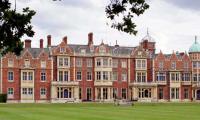With every passing day, destruction of the beautiful Margalla Hills goes on with grave implications for the climate and landscape of Islamabad. For over 40 years, stone crushers have been chipping away at the hills – quarrying, drilling and crushing bulky limestone rocks into pebbles that go into building roads, houses, air strips and cement-manufacturing.
The high-quality limestone rocks of the Margalla are thought to be the most suitable stone (gravel) for mixing in concrete and are thus widely used in building roads and air strips. These rocks have been used in laying the motorway and the Gwadar air strip. This is why the Margalla hills are depleting fast. A stretch of more than six kilometres has already been laid bare by miners, crushers, cement manufacturers and real estate dealers.
The Margalla hills lie both in the jurisdiction of the federal capital and the Punjab government as they run 40 kilometres from Chathar to Attock. Only a portion of the hills spread over 31,142 acres adjacent to Islamabad city, have been declared part of the Margalla Hills National Park under the wildlife ordinance of 1979. Mining is mostly carried out on the western side of the hills in the Taxila tehsil of the Rawalpindi district and some on the eastern side of the mountain facing the federal capital.
In 1990, knowing well the significance of these hills, the authorities allowed a cement factory to be set up and granted it a lease to mine limestone in an area that had been declared the Margalla Hills National Park way back in 1980. Ironically, after the cement factory commenced its operations, the then prime minister ordered protection of the national park and an end to the quarrying of stone in the park area.
After the then prime minister Nawaz Sharif’s orders in 1991, it took the Punjab government another 11 years to notify a buffer zone of 1000 yards from the outer limits of the federal capital territory. As a result, in 2003, the Punjab government prohibited mining in an area of 480 acres where 109 stone-crushing sites were located. However, the authorities failed in stopping illegal mining and crushing activities in the buffer zone for long. Some sort of illegal mining is still continuing.
During the process of crushing, a considerable amount of dust is released at almost every stage. This process not only affects the local environment but also human health in the surrounding areas. Further, removal of vegetation exposes soil surface and thereby enhances the chances of land erosion.
Studies conducted by the EPA Punjab and Pak-EPA since 2010 show that particulate emissions from stone-crushing are 33 to 40 times more than the environment quality standards. The crushing activity also destroys the natural habitat for 38 species of mammals and over 600 plant species in the Margalla Hills National Park. Limestone exploitation is altering the natural ecosystem and biodiversity of the hills.
In April 2009, the secretary of Punjab’s mines and minerals department wrote to the province chief minister: “The mining being done at [the] Margalla Hills of Tehsil Taxila, District Rawalpindi is an ecological and environmental disaster, causing harm to environment and human life…This matter [must] be dealt with zero tolerance and no violation should occur.”
As if stone crushing and cement factories were not enough to mutilate the hills, the Capital Development Authority (CDA) looked the other way when a host of housing societies were set up in the protected area. Under the law, commercial activity or residence in this area is prohibited. However, hotels, housing societies and a cement factory were built in the park on the western side of the hills.
On several occasions, the Supreme Court intervened and directed the authorities to protect the national park, but the court orders have not been fully implemented. In 2011, the federal government violated the court orders by renewing the lease of the private cement factory to mine and crush limestone in the park area. It is estimated that nearly 4,000 tonnes of limestone is excavated on a daily basis, resulting in deforestation.
In 2012, the federal government went a step ahead and started a project to build a tunnel – passing through the Margalla hills – that would connect the capital to Khyber Pakhtunkhwa. In October 2013, the Supreme Court halted this project.
The whole purpose of a national park is conservation and protection. Ideally, there should be very little human activity, and mostly for research, in the core areas of national parks. However, due to its location the Margalla National Park has become a recreational spot for people, which disturbs its flora and fauna.
As Islamabad city is expanding, there is a need to extend the limits of the buffer zone. On the contrary, efforts are underway to allow stone crushing within the zone by interpreting the law in favour of stone crushers and redrawing the boundaries of the buffer zone.
There are other limestone-rich sites such as the Salt Range hills, Koh-e-Suleman, located far from the densely-populated cities of Islamabad and Rawalpindi that can fulfil the national demand for limestone. Keeping in view the expansion of the twin cities as main urban centres, the mining and crushing of the Margalla hills should be gradually phased out.
Email: adnanadilzaidi@gmail.com
Now, court can only act upon applications filed under its jurisdiction
Fact is that let alone Pakistan, Trump hasn’t really spoken much for any South Asian country, not even India
By embracing quantum mechanics, humanity has unlocked technologies once thought unimaginable
Regular reporting could ensure accountability and adaptive management
Report assesses readiness of over 190 countries to meet demands of the international job market
In Pakistan, prospect of introducing Starlink has been topic of discussion, particularly due to frequent internet...







